|
Ida McKinley
A Sad Trajectory to the White House
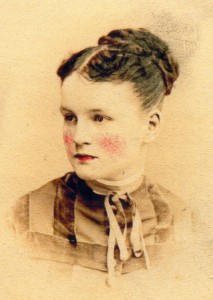 The
State of Ohio has a long history of producing Presidents of the United
States. In fact, Ohio is tied at the top of the list with the State of
Virginia in that regard with eight presidents each. Although William
Henry Harrison was not born in Ohio, he had adopted Ohio as his home
when he was elected. The others, all born in Ohio, were Ulysses S Grant,
Rutherford B. Hayes, James A Garfield, Benjamin Harrison, William
McKinley, William Howard Taft, and Warren G. Harding. Since this writer
was raised in Canton, Ohio, home of William McKinley, our 25th
President, this article will feature Ida Saxton McKinley. The
State of Ohio has a long history of producing Presidents of the United
States. In fact, Ohio is tied at the top of the list with the State of
Virginia in that regard with eight presidents each. Although William
Henry Harrison was not born in Ohio, he had adopted Ohio as his home
when he was elected. The others, all born in Ohio, were Ulysses S Grant,
Rutherford B. Hayes, James A Garfield, Benjamin Harrison, William
McKinley, William Howard Taft, and Warren G. Harding. Since this writer
was raised in Canton, Ohio, home of William McKinley, our 25th
President, this article will feature Ida Saxton McKinley.
As grade-schoolers my brother, sister & I spent
many a day at McKinley Monument in Monument Park, Canton, Ohio, which
was not far from our house. Those were the days when children could
safely be out of their parents’ sight and we spent most of our
non-school days somewhere that often neither Mom nor Dad ever knew.
Now part of the McKinley National Memorial, the
monument building stands high atop a hill created during its
construction after his death in 1901 by the addition of 35,000 cubic
yards of soil sculpted into four terraces with 108 steps leading to the
monument itself. We spent hours running up those steps and rolling down
the hill until we could no longer stand up. The complex today includes
the McKinley Presidential Library and Museum.
Ida Saxton, born June 8, 1847, was the daughter of a
successful property owner and banker at the Stark County Bank that he
established in Canton, and the granddaughter of the founder of the local
newspaper, The Canton Repository, which is still being published
today. Her mother was highly educated, having attended two boarding
schools, and was a strong advocate of equal higher education for women.
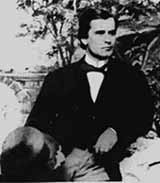 Ida
attended Canton Union School then followed her previous principal and
teacher to Delphi Academy in New York where she had transferred. This
principal and teacher, Betsy Cowles, had founded the Ohio Women’s
Rights Association as well as the Women’s Anti-Slavery Society in
Canton, and became one of Ida’s mentors, heavily influencing her. From
Delphi it was on to The Sanford School in Cleveland, Ohio, and then to
Brooke Hall Female Seminary in Media, Pennsylvania. The latter was more
of a finishing school where Ida learned the aspects of social etiquette
and what was perceived at the time as the necessities required to manage
a prosperous household. Included was instruction in singing, fine
needlepoint, linguistics, and mastering at least one musical instrument.
Ida developed her previous skills on the piano, and while there also
developed a passion for attending concerts, opera and the theater.
Encouraged by her teacher and friend, Harriet Gault, who believed that
women should be as physically active as men, Ida took vigorous long
daily hikes too. Ida
attended Canton Union School then followed her previous principal and
teacher to Delphi Academy in New York where she had transferred. This
principal and teacher, Betsy Cowles, had founded the Ohio Women’s
Rights Association as well as the Women’s Anti-Slavery Society in
Canton, and became one of Ida’s mentors, heavily influencing her. From
Delphi it was on to The Sanford School in Cleveland, Ohio, and then to
Brooke Hall Female Seminary in Media, Pennsylvania. The latter was more
of a finishing school where Ida learned the aspects of social etiquette
and what was perceived at the time as the necessities required to manage
a prosperous household. Included was instruction in singing, fine
needlepoint, linguistics, and mastering at least one musical instrument.
Ida developed her previous skills on the piano, and while there also
developed a passion for attending concerts, opera and the theater.
Encouraged by her teacher and friend, Harriet Gault, who believed that
women should be as physically active as men, Ida took vigorous long
daily hikes too.
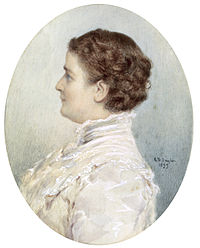 Upon
her graduation, Ida, now 21, worked for her father as a clerk, then a
cashier, and was occasionally entrusted with management of the bank when
her father was out of town. This position conjured up local disapproval,
especially from the all-male staff of the bank that felt she was an
over-educated female and out of her element. Ida taught Sunday school at
the First Presbyterian Church and helped her grandfather, who had
established the church, in his visits to indigents, the housebound and
the ill by providing food, comfort and monetary assistance. Upon
her graduation, Ida, now 21, worked for her father as a clerk, then a
cashier, and was occasionally entrusted with management of the bank when
her father was out of town. This position conjured up local disapproval,
especially from the all-male staff of the bank that felt she was an
over-educated female and out of her element. Ida taught Sunday school at
the First Presbyterian Church and helped her grandfather, who had
established the church, in his visits to indigents, the housebound and
the ill by providing food, comfort and monetary assistance.
From June to December 1869 Ida and her sister, Mary,
took a chaperoned grand tour of Europe. Her father paid the expenses for
Canton schoolteacher, Jeanette Alexander, to chaperone the group through
Ireland, Scotland, England, Holland, Belgium, France, Germany, Austria,
and Switzerland. Ida demonstrated her talents for managing money and
converting all the various currencies. She also developed empathy for
working women there performing manual labor for menial wages to support
themselves, especially the women of Belgium who handcrafted the lace for
which the country is known. Ida purchased large amounts of their work,
and thus began her lifelong collection. Her letters home described
visiting castles, museums, and bargain hunting, but also mentioned the
onset of migraine-like headaches. While on the trip Ida received the
news by mail that her fiance, Confederate Army Major John Wright, had
died.
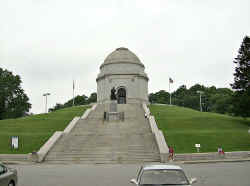 Upon
her arrival back home, Ida resumed her work at the bank, as well as an
active social life, becoming quite a belle with beautiful blue eyes and
auburn hair. Early in 1870 a man named William McKinley, President of
the YMCA, gave an introduction to lecturer and political activist Horace
Greely, and Ida was impressed with McKinley’s eloquent introduction
and his apparent values. McKinley later became Stark County Prosecutor,
and Ida’s father hired him to pursue claims on his behalf at which
McKinley was successful. Upon
her arrival back home, Ida resumed her work at the bank, as well as an
active social life, becoming quite a belle with beautiful blue eyes and
auburn hair. Early in 1870 a man named William McKinley, President of
the YMCA, gave an introduction to lecturer and political activist Horace
Greely, and Ida was impressed with McKinley’s eloquent introduction
and his apparent values. McKinley later became Stark County Prosecutor,
and Ida’s father hired him to pursue claims on his behalf at which
McKinley was successful.
Ida Saxton became Ida Saxton McKinley on January 25,
1871 in the first wedding ceremony to be held at the First Presbyterian
Church her father and grandfather had helped to build. The ceremony was
officiated jointly by Ida’s Presbyterian minister and William’s
Methodist minister. The couple honeymooned on the East Coast, then
returned to Ida’s father’s house in Canton that they leased.
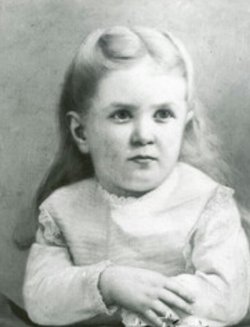 Their
first child, Katherine (Katie) was born there on the couple’s first
Christmas together. Their second child, Little Ida, born April 1, 1873,
lived only four and a half months. Two years later Katie became ill and
died. Ida began suffering severe headaches, depression, and seizures.
She was placed under the care of Philadelphia neurologist Silas
Mitchell, who had developed the "rest cure" for women with
problems of both physical and emotional natures. It was his belief that
women’s brains were incapable of coping with difficult issues, so he
forced them into a sedentary lifestyle. In Ida McKinley’s case, as we
know today, such dictated inactivity may have been what led to chronic
phlebitis later. Their
first child, Katherine (Katie) was born there on the couple’s first
Christmas together. Their second child, Little Ida, born April 1, 1873,
lived only four and a half months. Two years later Katie became ill and
died. Ida began suffering severe headaches, depression, and seizures.
She was placed under the care of Philadelphia neurologist Silas
Mitchell, who had developed the "rest cure" for women with
problems of both physical and emotional natures. It was his belief that
women’s brains were incapable of coping with difficult issues, so he
forced them into a sedentary lifestyle. In Ida McKinley’s case, as we
know today, such dictated inactivity may have been what led to chronic
phlebitis later.
Following his election to the US House of
Representatives, in 1877 William went alone to Washington, DC, while Ida
rested. But Ida did not want to become an invalid. She knew the
difficulty she was causing her husband, and worked diligently to improve
her situation. She eventually was able to travel with him, and by 1880
had assumed a prominent role as a congressional spouse by helping place
women who needed to support themselves into federal jobs.
The couple was seldom apart, as William kept the door
between the parlor, where Ida sat and knitted, and his office open in
their hotel suite. She therefore became privy to even his most
confidential meetings. She was particularly helpful in promoting the
protectionist tariff on which William was building a national
reputation. The Congressman refused to leave her side when she was ill,
as she frequently was, and his constituents began thinking of him as
saint-like and sacrificial, a model of compassion.
William McKinley was elected Ohio's governor in 1891.
The couple took lodging opposite the State House in Columbus. William
never left his wife unattended, but when he went to the office across
the street, he signaled Ida each afternoon at 3pm. She in turn would
wave her handkerchief at him. Among his accomplishments while governor
were improving the tax system, passage of a railroad safety law,
establishment of a state board of arbitration for labor disputes, and he
also was forced to deal with a coal miners' strike.
During their four years in Columbus, Ida’s health
seemed to improve. She became more active socially, entertained more,
and she stood in reception lines as long as she could. They went to
concerts, operas, and plays. At home they played cribbage.
To celebrate their 25th wedding
anniversary Ida planned a large party, inviting way too many people for
their house to accommodate, so they entertained their guests in two
sessions. Ida managed successfully to host 600 people over a period of 6
hours. William McKinley served two terms as Governor of Ohio.
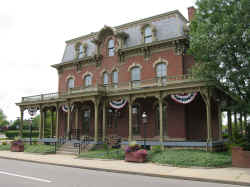 In
1896 when he was campaigning for the presidency, his staff organized a
Women’s McKinley Club in Canton, and produced campaign buttons with
Ida’s picture on them, also distributing a romanticized biography of
her. These actions were taken to counteract brutal accusations aimed at
both Ida and her husband during a nasty campaign. Front Porch Campaigns,
where politicians addressed visitors from their own front porches, were
the norm during that period. Few visitors during these gatherings saw
Ida, for she had begun having recurring seizures. At this time in
history, seizures were associated with mental illness. The biography was
to counteract such rumors. William’s marital devotion was used to
appeal to the mostly male voters, since women’s suffrage was not yet
universal. In
1896 when he was campaigning for the presidency, his staff organized a
Women’s McKinley Club in Canton, and produced campaign buttons with
Ida’s picture on them, also distributing a romanticized biography of
her. These actions were taken to counteract brutal accusations aimed at
both Ida and her husband during a nasty campaign. Front Porch Campaigns,
where politicians addressed visitors from their own front porches, were
the norm during that period. Few visitors during these gatherings saw
Ida, for she had begun having recurring seizures. At this time in
history, seizures were associated with mental illness. The biography was
to counteract such rumors. William’s marital devotion was used to
appeal to the mostly male voters, since women’s suffrage was not yet
universal.
William was elected to the Presidency in 1896.
Previous First Ladies with medical problems usually remained at home out
of the limelight, but Ida intended to enjoy her time as First Lady.
Consequently after a day filled with inaugural activities, and having
pushed herself greatly, she ‘fainted,’ as her seizures were often
labeled, while leading the Grand March. Aides moved her to a cloakroom,
and when she came to they took her to the White House.
The White House staff became adept at handling
situations when Ida suffered seizures too and carefully assisted her out
of the room and took her upstairs. At state receptions, Ida usually sat
in a chair and nodded to the dignitaries that her husband introduced to
her. At dinners, the President, contrary to the custom of having
dignitaries sit next to the President, insisted on Ida occupying one of
the chairs at his side so he could cover her face with a handkerchief if
she had a seizure. Seizure completed, he would simply remove the
handkerchief and continue his conversations as if nothing had happened.
On occasion, she augmented her presence at public social events in the
White House with social aides who included one of several nieces, her
sister Mary and Jennie Hobart, the wife of the Vice President.
While in the White House, Ida was treated by a series
of surgeon generals in an effort to get her seizures under control. At
one point William was receiving unregulated dosages of bromides, which
did stop the seizures, but ended up causing more serious medical
problems such as depression and headaches. Only one physician, Preston
Rixey, succeeded in diminishing the frequency of Ida’s seizures, and
that was accomplished by strict regulation of her schedule and her
nutrition.
Ida received friends and official visitors both
mornings and afternoons in her own reception room at the White House.
She and William frequently had guests for their 1:00 luncheon, and once
she held a reunion of her classmates from Brooke Hall. Still, she went
out less often than previous first ladies and spent much of her time
alone reading, knitting or crocheting thousands of pairs of
leather-soled slippers for soldiers, orphans, and widows or for
auctioning to benefit charities. She sent flowers from the White House
greenhouse every Sunday to the Metropolitan Church requesting that they
be sent to invalids or hospital patients after the service.
Because of her love of music and theater, Ida
McKinley sponsored numerous unique musical events at the White House and
initiated the practice of providing entertainment to guests after formal
dinners. She was responsible for the introduction of the popular new
genre of ragtime for the first time at the White House.
Ida slowly began influencing the President by
assisting him in early drafts of his speeches and providing her input on
the character of those persons attempting to obtain appointments. The
couple was able to exchange ideas privately during their daily carriage
rides around town. After the explosion of the USS Maine in the harbor at
Havana, Cuba, and the United States’ Declaration of War against Spain,
her favorable opinion of her physician, US Army surgeon Leonard Wood,
was influential in his being named Colonel of the famous Rough Riders
who fought Spanish troops in Cuba. When Lieutenant Colonel Theodore
Roosevelt was trying to get authorization to transfer the Rough Riders
from San Antonio, Texas, to ships in Florida to embark for Cuba, Ida
managed to influence the deployment. During the War, she and the
President both visited several large military training camps in the
United States.
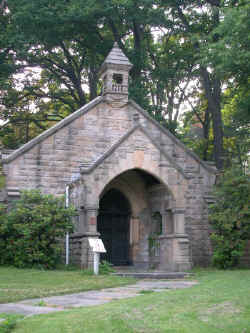 Ida
lobbied William to retain the Philippines as US territory after the War,
and supported and facilitated the appointment of a woman to the American
delegation at the Paris Exposition. She refused to let the Women’s
Christian Temperance Union force her into eliminating alcohol from White
House activities. Ida became an acquaintance of Susan B. Anthony,
strongly supporting women’s right to vote and the right to equal
higher education. Ida
lobbied William to retain the Philippines as US territory after the War,
and supported and facilitated the appointment of a woman to the American
delegation at the Paris Exposition. She refused to let the Women’s
Christian Temperance Union force her into eliminating alcohol from White
House activities. Ida became an acquaintance of Susan B. Anthony,
strongly supporting women’s right to vote and the right to equal
higher education.
In the latter half of 1899 Ida began suffering
serious seizures, followed by a prolonged period of depression. One can
only speculate why depression set in. Perhaps it was the seizures
themselves, or that she now had to use a wheelchair most of the time.
But William had also decided to seek a second term, and that meant no
retirement as she had planned and hoped.
She was, however, well enough a month after McKinley’s
second inauguration to depart on a trans-continental trip by rail with
him. On that trip she granted her only full-length newspaper interview
as First Lady. She also accepted an invitation to an impromptu brunch to
honor her across the bridge from El Paso, in Juarez, Mexico, at a
private home, thus making her the first incumbent First Lady to visit a
foreign country. President McKinley remained in El Paso. Later in the
trip a cut on Ida’s finger became infected, progressing to blood
poisoning, forcing the entourage to pause the itinerary and establish a
base at a private home in San Francisco. McKinley conducted the nation’s
business from there for nearly two weeks while Ida recovered. Since she
was seriously ill, regular bulletins were issued to the nation updating
her condition. Once she was improving, the party hastily traveled east
to the White House, where Ida was able to recuperate for another month.
Then the couple went to their home in Canton for the remainder of the
summer.
Four months later, the President and First Lady
traveled to Buffalo, NY for the Pan-American Exposition. Ida’s
appearance in the grandstand was captured on a movie camera, making her
the first First Lady to be filmed. But while there Ida avoided most of
the Exposition’s venues because of the large crowds. She consequently
was not present when at the Temple of Music, while in a receiving line
for the public Leon Czolgosz shot President William McKinley.
During the next six days, it seemed for a time as if
McKinley might recover. Ida was surprisingly strong, both physically and
emotionally. When the physicians decided that he Presdient could not
recover, they allowed Ida to see him once more, carefully choosing the
time so Ida would not have to witness the moment of his death.
Of course, Ida was crushed by her husband’s death.
The three-day itinerary of the funeral train from Buffalo to Washington
for a service at the United States Capitol, and then to Canton must have
been grueling. And from the fall of 1901 to the spring of 1904, Ida
visited her husband’s coffin in the Werts Receiving Vault at West Lawn
Cemetery until his memorial was built. Except for these visits, Ida did
not leave her home, stating she expected William’s ghost to visit her
there. She did, however, resume public activities after attending the
laying ceremony of the cornerstone to McKinley’s monument on November
16, 1905. She continued her work on behalf of individuals seeking
political appointments, and planned to visit the Philippines.
Ida was anxiously awaiting the completion of the
McKinley Monument but she died on May 26, 1907 at the age of 59 years,
four months before its dedication. So she survived the president by less
than six years and was buried next to him in the monument on an altar in
the center of the rotunda in a pair of marble sarcophagi. Their young
daughters rest in the wall directly behind them.
Ida Saxton McKinley’s birthplace, childhood home
and later married home is still standing in Canton, Ohio, and is now
part of the National First Ladies Historic Site. It includes the Ida
Saxton McKinley Historic Home and another building, just a block north,
the Education & Research Center where the museum is housed.
Illustrations in order:
Ida Saxton as a young student - Courtesy National
First Ladies' Library
Wm. McKinley at the time of his courtship of Ida
Saxton - Courtesy McKinley Presidential Library
Official White House portrait of Ida Saxton
McKinley
McKinley Monument, Canton OH
Katie McKinley - Courtesy National First Ladies'
Library
Saxton McKinley House in Canton OH, Nat'l First
Ladies Historic Site
Werts Receiving Vault where McKinley was interred
for six years |